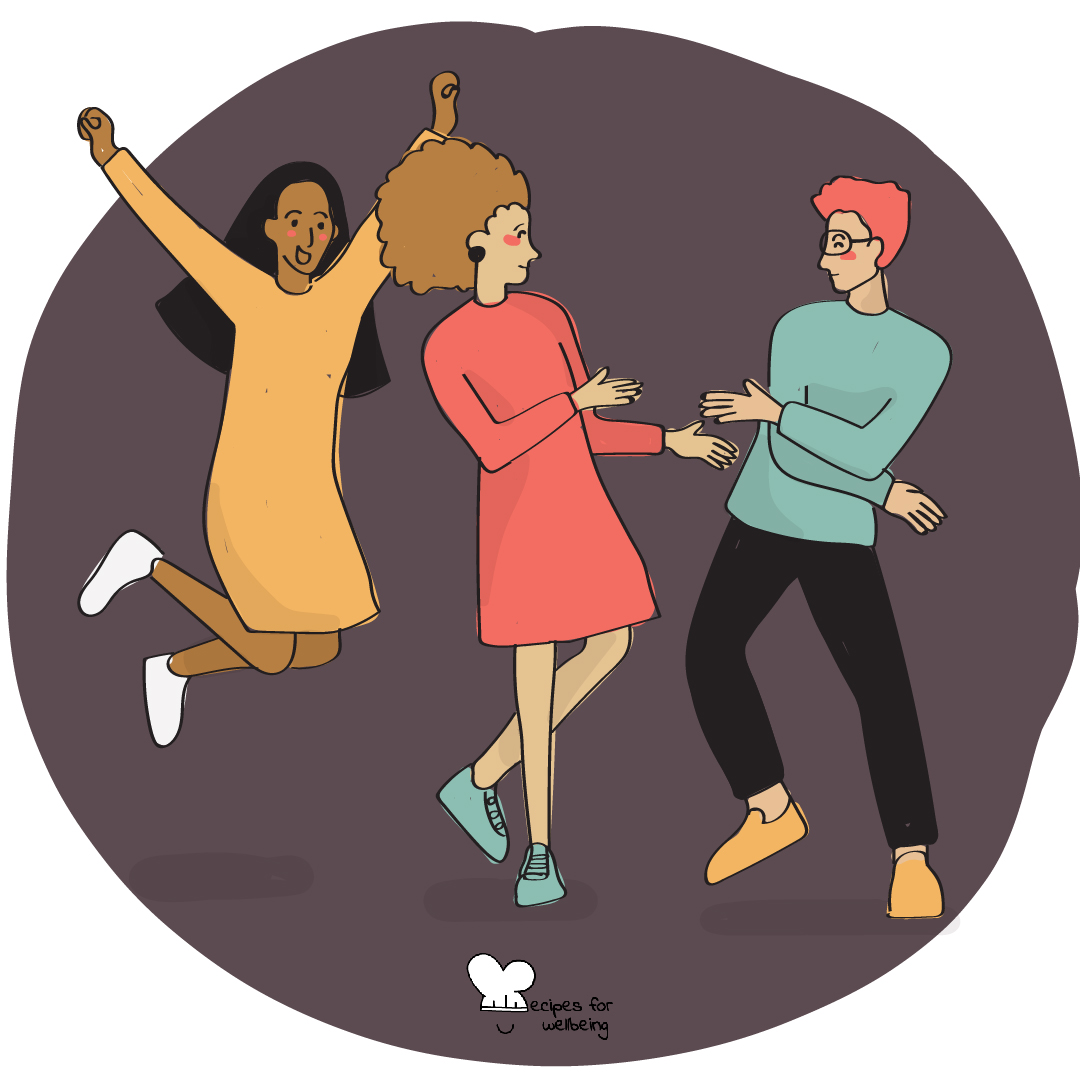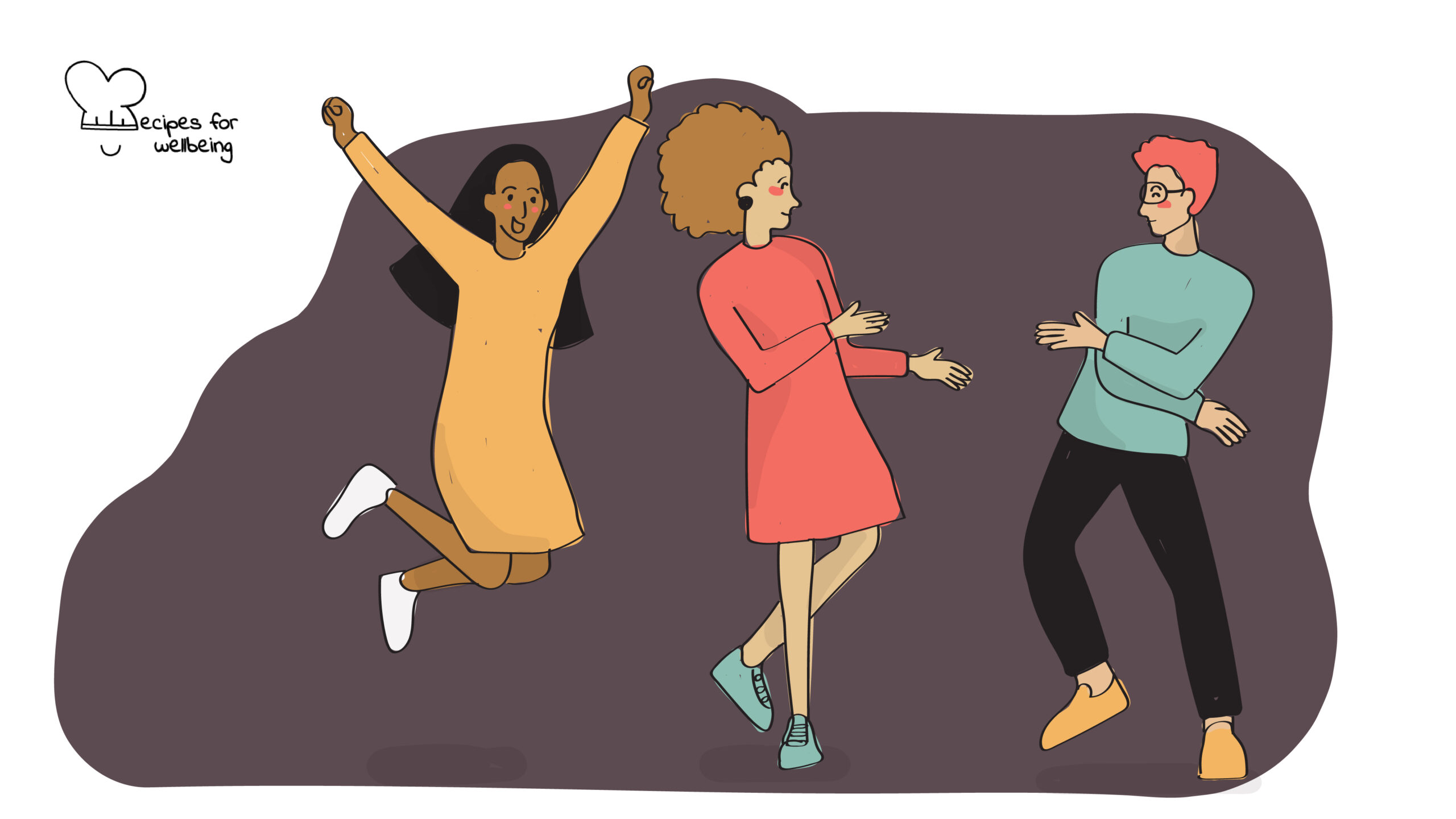
Ecstatic dance
I have found a language of patterns I can trust to deliver us into universal truths, truths older than time. In the rhythm of the body, we can trace our holiness, roots that go all the way back to zero. States of being where all identities dissolve into an eternal flow of energy. Energy moves in waves. Waves move in patterns. Patterns move in rhythms. A human being is just that, energy, waves, patterns, rhythms. Nothing more. Nothing less. ―Gabrielle Roth
👥 Serves: 1 person
🎚 Difficulty: Easy
⏳ Total time: 31-60 minutes
🥣 Ingredients: No judgement, comfortable clothing, a space to dance
🤓 Wholebeing Domains: Awareness, Liberatory Learning, Positive Emotion, Ritualising
💪 Wholebeing Skills: Fun, Happiness, Hosting yourself, Joy, Mind-body-connection, Movement

Ecstatic dance
📝 Description
Dance freely and ecstatically.
Dance has been included in rituals and celebrations since the start of time. Dance is present in many cultures, religions and now, as a form of therapy. A study done by the American Cancer Society suggests that dance and movement therapy can support emotional and mental health challenges, boost body image and self-esteem while reducing anxiety, isolation, and depression.
Ecstatic dancing strives for the same, albeit with a little more spirituality. The idea was created by Gabrielle Roth, a trained dancer and teacher who did so for more than 50 years before passing away in 2012. Roth studied and trained with psychologists, philosophers, anthropologists, and spiritual gurus in the 1960s, defining the movement, then known as 5rhythms.
With ecstatic dancing, everyone is a dancer. Everyone, including YOU, can unleash their inner dancer, with every movement peeling away another emotional layer and connecting you to your senses and body, allowing you to connect and find a deeper meaning in your life while removing stress and anxiety. You may feel great bliss afterwards, or very emotional, as it can be therapeutic dancing to heal trauma and past hurt.
While ecstatic dancing, you learn to disconnect from the beta brain waves that are active in your everyday life in problem-solving and connect to a deeper, trance-like state of theta brain waves. Theta brain waves are typically only present while we sleep or practise deep meditation but can be activated during the ecstatic dance. Theta brain waves are known to enhance creativity, intuition, memory, and learning.
This recipe has been created by our wellbeing content writer collaborator Marissa Del Mistro and inspired by the ecstatic dance movement of Gabrielle Roth. It can be practised alone or with others.
👣 Steps
Step 1 – Learn the ‘rules’ (5’)
Have you ever taken a dance class? If yes, you know there are plenty of rules and limits to each class. You may be relieved to learn that there are only 3 rules for ecstatic dancing.
- Rule #1: No alcohol or drugs.
- Rule #2: No talking.
- Rule #3: No judging.
That’s it! There is no set choreography, no set dance form, and no set music.
Step 2 – Prepare your space (5’)
If you are in a big city, there is a chance there is an ecstatic dance group that already exists (hey, if not, maybe you can start one!). Open your preferred search engine to check if such a group exists in your area.
If you don’t find one, or if you just prefer to do this exercise by yourself, you will want to set the scene. Close all of the blinds, turn down the lights, and move any furniture away so you have the freedom to move around without limitations. Kindly ask your housemate(s) or family members for around 30–45 minutes of undisturbed time. If you feel a bit silly telling them you are dancing, let them know you are doing a workout and not to disturb you.
Step 3 – Curate a playlist (2’)
If you opt to attend a group session, you can skip this step, as most groups have a DJ curating the session.
If alone, ecstatic dance music tends to be very diverse, ranging in style and tempos. Generally, it is more electronic, such as bass, house, tribal and trap. Here are a few of our favourite playlists:
- Ecstatic Dance • Amsterdam
- Ecstatic Dance Class
- Ecstatic Dance (compiled by a changemaker friend during a retreat for changemakers)
- Ecstatic Dance
You can find many other free playlists on Spotify or YouTube!
Step 4 – Dance like nobody’s watching (30’–45’)
Pump the music, close your eyes, and start dancing slowly doing whatever feels good. You can tap your feet, shimmy your shoulders, raise your hands, move in gentle circles, and roll your neck. You can determine how long you wish to dance for, but try and give it 30 minute at least.
Remind yourself to be present, focusing on the music and the beat and trust your body to move and express whatever it expresses. There is no move off-limit – nothing too feminine or masculine – just whatever feels natural and free. You may find yourself wanting to shake, jump, or you may wish to just sway.
During ecstatic dance, remember that there are no set moves, instead just move freely through the space. The goal is to reach a state of trance and ecstasy. Many dancers find that ecstatic dance brings them into a deep, meditative state, fully living in the present moment.
The different rhythms and beats of the music invite us, according to Gabrielle Roth, to “put the entire psyche into motion. That is to say, we need to be physically fluid, emotionally fluid, mentally fluid, and not locked into positions and beliefs and theories”.

